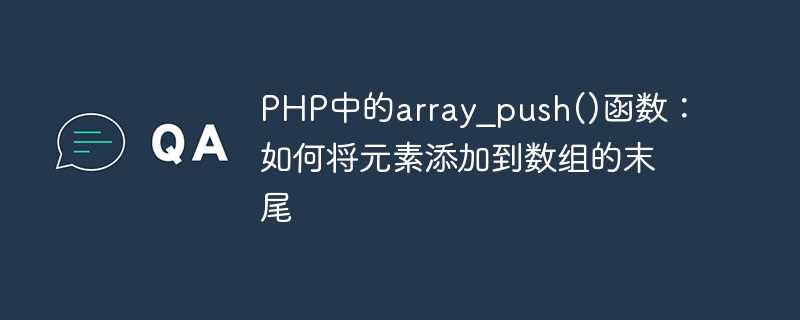 Backend Development
Backend Development
 PHP Tutorial
PHP Tutorial
 array_push() function in PHP: how to add elements to the end of an array
array_push() function in PHP: how to add elements to the end of an array
array_push() function in PHP: how to add elements to the end of an array

Array_push() function in PHP: How to add elements to the end of the array, with code examples
In PHP, arrays are a very important kind of data Type, which allows us to save and organize multiple values. Sometimes, we need to add new elements to an existing array. PHP provides an array_push() function to conveniently add elements to the end of an array. This article will introduce the usage of array_push() function and provide specific code examples.
First, let’s take a look at the syntax of the array_push() function:
array_push( $array, $element1, $element2, ... )
array_push() Functions accept two or more parameters. The first parameter is the array to which elements are to be added, and the following parameters are the elements to be added. We can add multiple elements at once and they will be added to the end of the array in the order of parameters.
Here is a simple example that demonstrates how to add elements to an array using the array_push() function:
$fruits = array("apple", "banana", "orange");
array_push($fruits, "grape", "watermelon");
print_r($fruits);Output result:
Array
(
[0] => apple
[1] => banana
[2] => orange
[3] => grape
[4] => watermelon
)In the above example, we First, an array containing three fruits is created. We then added two new fruits, "grape" and "watermelon", to the array using the array_push() function. Finally, we use the print_r() function to print the array, and we can see that the new fruit has been successfully added to the end of the array.
It should be noted that the array_push() function will add new elements to the end of the array and return the new length of the modified array. If we only care about adding elements and don't need to know the new length, we can ignore the return value. If the first argument passed to the array_push() function is not a valid array, an E_WARNING level error will be thrown.
In addition, in addition to the array_push() function, we can also use simple array syntax to add elements to the end of the array. For example, the same effect can be achieved using:
$fruits = array("apple", "banana", "orange");
$fruits[] = "grape";
$fruits[] = "watermelon";
print_r($fruits);The output result is the same as using the array_push() function.
To summarize, the array_push() function is a very convenient function in PHP that can help us add elements to the end of the array. It's very simple to use, you just need to provide the array to which you want to add elements and the elements you want to add. If you want to add multiple elements at once, just list them one after another in the function call. Alternatively, we can use simple array syntax to achieve the same effect. Either way, you can flexibly manage and manipulate data in the array.
The above is the detailed content of array_push() function in PHP: how to add elements to the end of an array. For more information, please follow other related articles on the PHP Chinese website!

Hot AI Tools

Undresser.AI Undress
AI-powered app for creating realistic nude photos

AI Clothes Remover
Online AI tool for removing clothes from photos.

Undress AI Tool
Undress images for free

Clothoff.io
AI clothes remover

AI Hentai Generator
Generate AI Hentai for free.

Hot Article

Hot Tools

Notepad++7.3.1
Easy-to-use and free code editor

SublimeText3 Chinese version
Chinese version, very easy to use

Zend Studio 13.0.1
Powerful PHP integrated development environment

Dreamweaver CS6
Visual web development tools

SublimeText3 Mac version
God-level code editing software (SublimeText3)

Hot Topics
 CakePHP Project Configuration
Sep 10, 2024 pm 05:25 PM
CakePHP Project Configuration
Sep 10, 2024 pm 05:25 PM
In this chapter, we will understand the Environment Variables, General Configuration, Database Configuration and Email Configuration in CakePHP.
 PHP 8.4 Installation and Upgrade guide for Ubuntu and Debian
Dec 24, 2024 pm 04:42 PM
PHP 8.4 Installation and Upgrade guide for Ubuntu and Debian
Dec 24, 2024 pm 04:42 PM
PHP 8.4 brings several new features, security improvements, and performance improvements with healthy amounts of feature deprecations and removals. This guide explains how to install PHP 8.4 or upgrade to PHP 8.4 on Ubuntu, Debian, or their derivati
 CakePHP Date and Time
Sep 10, 2024 pm 05:27 PM
CakePHP Date and Time
Sep 10, 2024 pm 05:27 PM
To work with date and time in cakephp4, we are going to make use of the available FrozenTime class.
 CakePHP File upload
Sep 10, 2024 pm 05:27 PM
CakePHP File upload
Sep 10, 2024 pm 05:27 PM
To work on file upload we are going to use the form helper. Here, is an example for file upload.
 CakePHP Routing
Sep 10, 2024 pm 05:25 PM
CakePHP Routing
Sep 10, 2024 pm 05:25 PM
In this chapter, we are going to learn the following topics related to routing ?
 Discuss CakePHP
Sep 10, 2024 pm 05:28 PM
Discuss CakePHP
Sep 10, 2024 pm 05:28 PM
CakePHP is an open-source framework for PHP. It is intended to make developing, deploying and maintaining applications much easier. CakePHP is based on a MVC-like architecture that is both powerful and easy to grasp. Models, Views, and Controllers gu
 CakePHP Working with Database
Sep 10, 2024 pm 05:25 PM
CakePHP Working with Database
Sep 10, 2024 pm 05:25 PM
Working with database in CakePHP is very easy. We will understand the CRUD (Create, Read, Update, Delete) operations in this chapter.
 CakePHP Creating Validators
Sep 10, 2024 pm 05:26 PM
CakePHP Creating Validators
Sep 10, 2024 pm 05:26 PM
Validator can be created by adding the following two lines in the controller.





